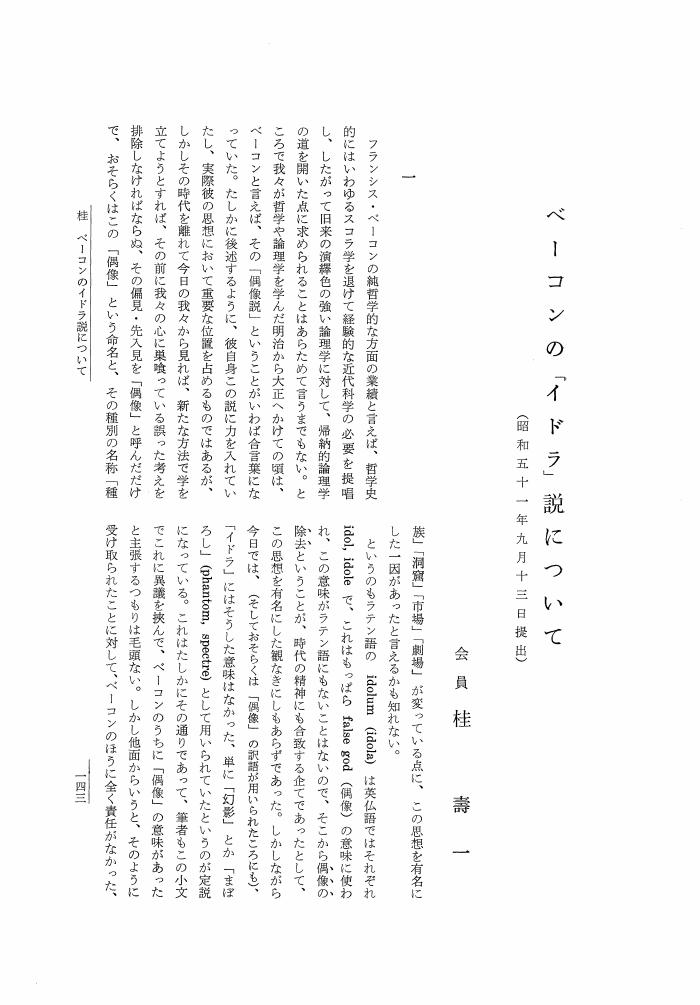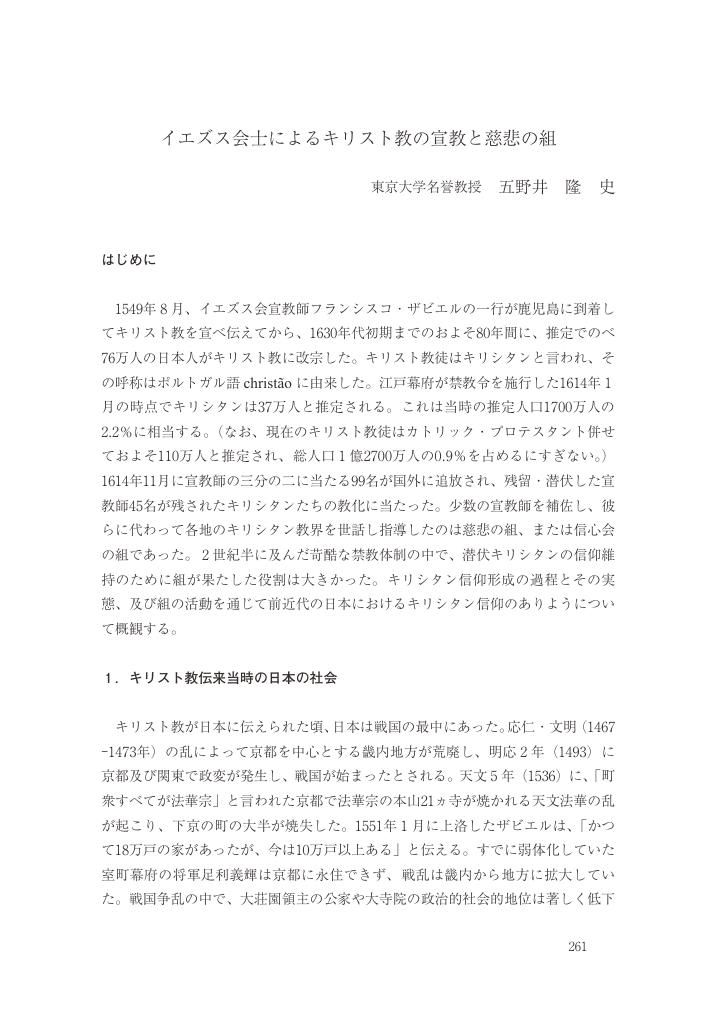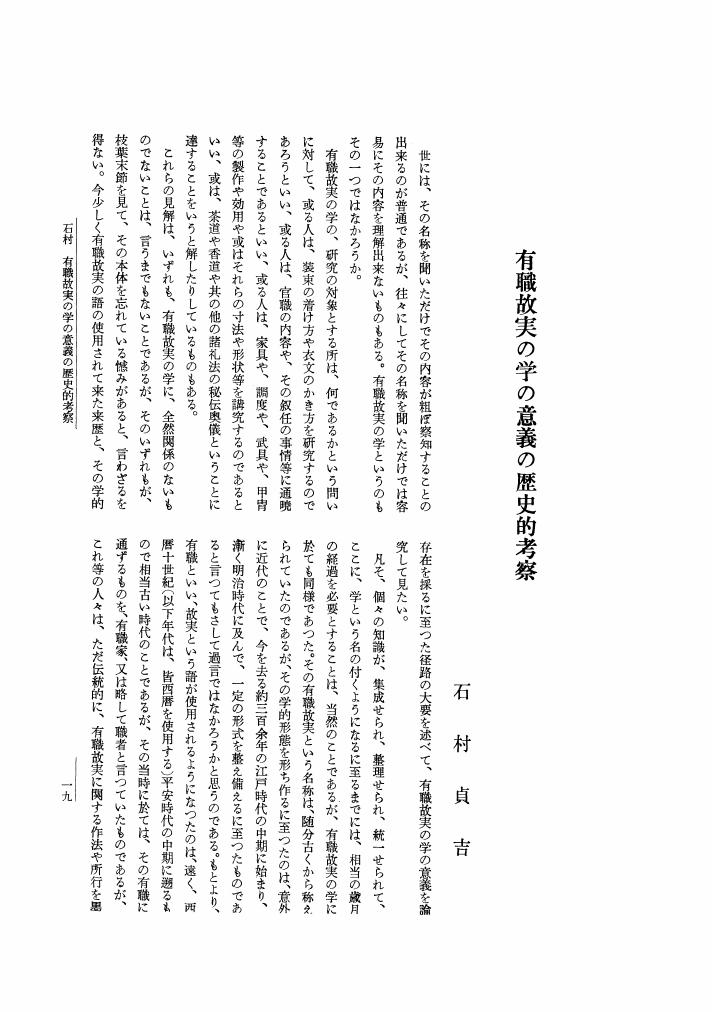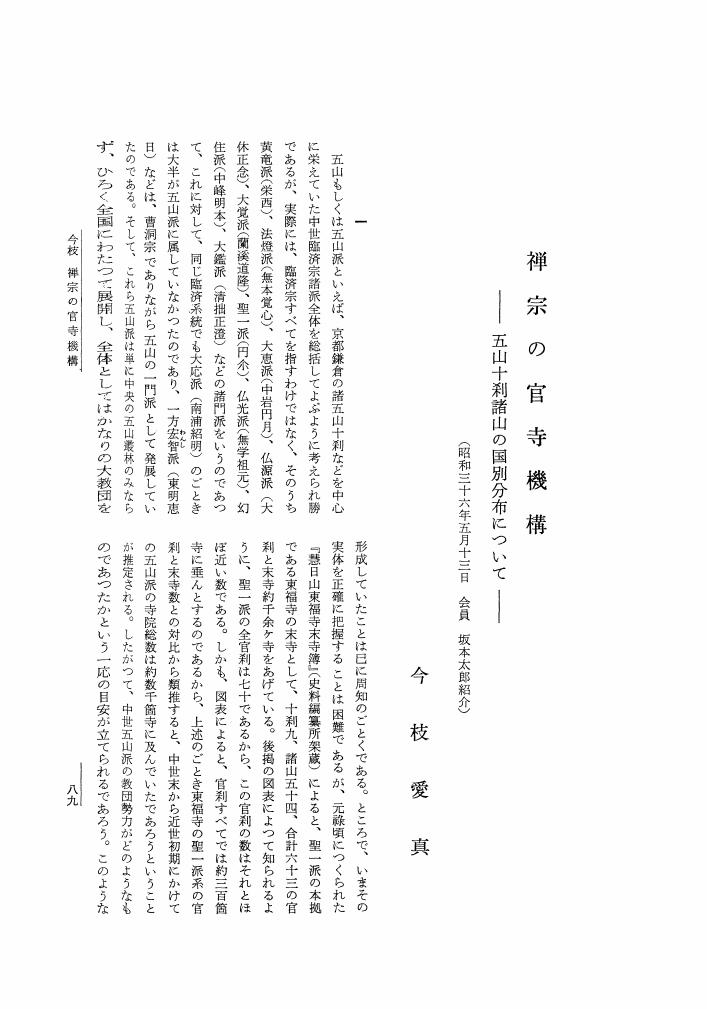3 0 0 0 OA 忘れられた歴史•地理学者北沢正誠 (昭和六十一年四月十四日 提出)
- 著者
- 岩生 成一
- 出版者
- 日本学士院
- 雑誌
- 日本學士院紀要 (ISSN:03880036)
- 巻号頁・発行日
- vol.42, no.1, pp.1-14, 1987 (Released:2007-06-22)
- 参考文献数
- 16
KITAZAWA was born to the family of a retainer of the lord Sanada of the Matsushiro fief in Shinano Province. He studied under Zozan SAKUMA in his youth and was much influenced by his teacher. After the Meiji Restoration, he obtained a position in the central government, representing the Matsushiro fief. After that, he entered the services of the Historiographical Bureau of Tokyo University, the Department of Foreign Affairs and so forth.In 1879 he made utmost efforts to establish the Tokyo Geographical Society, and since then, on the one hand he did much for its management and development, and on the other hand, devoted himself to the studies on history and geography, especially on those of Mongolia and Korea, which adjoin to China. Many papers and books, containing outstanding results of his studies concerning the said fields, were given to the public during that time.He acted as a headman of Koishikawa Ward and also as a government official of Ogasawara Islands. He was a teacher of Japanese literature and Chinese classics at Takada Middle School in his last several years and died in 1901.
3 0 0 0 OA ベーコンの「イドラ」説について (昭和五十一年九月十三日提出)
- 著者
- 桂 壽一
- 出版者
- 日本学士院
- 雑誌
- 日本學士院紀要 (ISSN:03880036)
- 巻号頁・発行日
- vol.34, no.3, pp.143-150, 1977 (Released:2007-05-30)
3 0 0 0 OA 「立憲主義」と「憲法制定権力」 : 対抗と補完 : 最近の内外憲法論議の中から
- 著者
- 樋口 陽一
- 出版者
- 日本学士院
- 雑誌
- 日本學士院紀要 (ISSN:03880036)
- 巻号頁・発行日
- vol.69, no.3, pp.105-128, 2015 (Released:2017-04-05)
3 0 0 0 OA 天皇社会、武家社会、産業社会
- 著者
- 富永 健一
- 出版者
- 日本学士院
- 雑誌
- 日本學士院紀要 (ISSN:03880036)
- 巻号頁・発行日
- vol.71, no.3, pp.137, 2017 (Released:2017-04-13)
This is a study on the history of Japanese society based on three divisions, namely, the Ancient Stage, the Middle Stage, and the Modern Industrial Stage. As a country, Japan emerged during the fifth century under the name Yamato Chotei. Previously, it consisted of many small Uji and Kabane communities without the integrated and central control of Tenno domination under the name of “shiseisei”(氏姓制). It consisted of many small competing local areas, that fought incessantly between them. The important emperor Tenji Tenno(626–671), leader of the Taika-no-Kaisin , made a significant break to the traditional institution of the “shisei-sei” by introducing a new body that became known as “Handenshuju-sei”(班田収授制 in 律令制) in the year 645. The end result was the founding in 710 of the new capital Heijo-kyo in the city of Nara under the reign of Empress Genmei Tenno . However, the city of Nara was greatly affected by the sudden decision in 794 taken by Emperor Kanmu Tenno to make the city of Kyoto the country's capital. Although some may hold the view that there were similarities between the neighboring cities of Nara and Kyoto, they were dissimilar in most respects . In the city of Nara, land was divided under the measures of the nationalization plan. Conversely, in the city of Kyoto, land was divided according to measures of privatization. Also, in Nara the state drafted the Handenshuju plan, while in Kyoto there were no such plans. The result of these policies was that in Kyoto the land was owned by the wealthy, large religious institutions, and Buke families. In Nara, however, under Ritsryosei , common people were taxed so heavily that they escaped from the city to the countryside. As the premature Tenno continued to expand, it became necessary for them to be covered by “Sessho” and “Kampaku” until the Tenno matured. The growing Tenno needed such support, which led Sessho and Kampaku to acquire additional influence and power. The first Buke Society began in Kamakura Bakufu under Minamoto Yoritomo. Yoritomo married Masako of the Hojo family, and she was an able and strong woman. After the death of her husband, she became the head of the Kamakura Bakufu . Shugo and Jito were both Buke, and Yoritomo appointed them as the lords of the manor(荘園領主). However, Chotei and Bakufu were at odds with each other. Bakufu was stronger than Chotei in terms of military might, when they battled in 1221, in what became known as Jokyu-no-Ran, Bakufu was victorious. After the Jokyu-no-Ran, the large Mongolian Army attacked Japan on two occasions(Bun-ei no-Eki, 1274, and Koan-no-Eki, 1281), but were defeated each time by the Japanese defenders. However, the cost of these battles was great, and the Japanese army found itself impoverished. Another important event resulted from the dispute over the succession of the Tenno throne between the two lines consisting of the Jimyoin-party and the Daigakuji-party. Godaigo Tenno of the Daigakuji-party wanted to gain the crown by overthrowing the Bakufu. However, Godaigo was unsuccessful and this led him to create the “Nancho”(South Side). Meanwhile, Ashikaga Takauji, who supported the “Hokucho”(North Side) of Kyoto, kept to his own side leaving Chotei divided between North and South. As a result, Kamakura Bakufu was ruined, and Muromachi Bakufu was rebuilt by Ashikaga Takauji ]in Kyoto as the second Bakafu. (View PDF for the rest of the abstract.)
3 0 0 0 OA 古今集序の六義についての研究 中国の六義との比較を主として
- 著者
- 小沢 正夫
- 出版者
- 日本学士院
- 雑誌
- 日本學士院紀要 (ISSN:03880036)
- 巻号頁・発行日
- vol.14, no.1, pp.27-63, 1956 (Released:2007-05-30)
3 0 0 0 古今集序の六義についての研究
- 著者
- 小沢 正夫
- 出版者
- 日本学士院
- 雑誌
- 日本學士院紀要 (ISSN:03880036)
- 巻号頁・発行日
- vol.14, no.1, pp.27-63, 1956
3 0 0 0 OA イエズス会士によるキリスト教の宣教と慈悲の組
- 著者
- 五野井 隆史
- 出版者
- 日本学士院
- 雑誌
- 日本學士院紀要 (ISSN:03880036)
- 巻号頁・発行日
- vol.72, no.Special_Issue, pp.261-272, 2018-04-11 (Released:2018-05-23)
3 0 0 0 OA 有職故実の学の意義の歴史的考察
- 著者
- 石村 貞吉
- 出版者
- 日本学士院
- 雑誌
- 日本學士院紀要 (ISSN:03880036)
- 巻号頁・発行日
- vol.12, no.1, pp.19-38, 1954 (Released:2007-05-30)
3 0 0 0 OA 幕末経済史再考
- 著者
- 石井 寛治
- 出版者
- 日本学士院
- 雑誌
- 日本學士院紀要 (ISSN:03880036)
- 巻号頁・発行日
- vol.74, no.2, pp.65, 2019 (Released:2020-01-16)
- 参考文献数
- 27
The industrial revolution in Japan in the latter half of the 19th century, the first industrial revolution in Asia, did not depend on foreign capital until 1899, when the Japanese government called off the prohibition on foreign capital investment. This change was a result of Japanese law courts beginning to consider the crimes of foreigners in Japan. Even after 1899, the amount of foreign capital used in private enterprises within Japan was unexpectedly small. In 1914, only 7% of all stocks and debentures of private enterprises were foreign-owned. How did Japanese entrepreneurs then raise money for industrialization? Big enterprises raised money domestically through joint-stock companies. The stockholders invested not only their own money but also money borrowed from banks using their stocks as security. Most stockholders were merchants and financiers, including those who started their businesses in the Edo era. Although the loan business with the merchants set up by the biggest moneychangers, such as Mitsui and Kounoike, was said to be declining toward the end of the Edo era, it is notable that the draft business, which promoted modernization of the economy, was growing. In Japan, payment to distant clients by bills of exchange began in the 13th century, and payment to nearby clients by such bills began in the 17th century. However, Japanese moneychangers did not develop a business around discounting bills because Japanese merchants did not use terminable promissory notes. In this paper, I first discuss cases of settlement of transactions involving cotton goods and fertilizers between Owari (present-day western Aichi Prefecture) and Edo (present-day Tokyo) by bills of exchange. I also discuss cases of settlement for trade of cotton goods and tea between Yokohama and Kamigata (present-day Osaka and Kyoto) by bills of exchange. The latter cases were important in keeping foreign merchants from making inroads into Japan’s market. It also led to Japanese merchants accumulating capital via cash payments with foreign merchants in Yokohama. I then discuss cases of settlement among merchants by bills of exchange in Kamigata in the late Edo era. Such settlements became common in Osaka as well as its suburbs, thereby reducing the loan interest rate to approximately 6%, which was almost half of that in Edo. In Osaka, bills of exchange could be settled by many moneychangers who were further controlled by the biggest moneychangers, particularly Kounoike, Mitsui, and Kajimaya. Contrary to popular belief that Mitsui was in financial straits by the end of the Edo era, the real situation of Mitsui was promising when the draft business was taken into account. Although many moneychangers went bankrupt during the Meiji Reform, a considerable number of them survived the phase. Additionally, many powerful newcomers such as Chojiya, Nunoya, and Yasuda began operating during this period. Some of these moneychangers even established modern banks. The most important suppliers of capital for the industrialization in Japan were the merchants, both old and new, headed by moneychangers.
3 0 0 0 OA 行政法概念の諸相 : 中核と周辺
- 著者
- 塩野 宏
- 出版者
- 日本学士院
- 雑誌
- 日本學士院紀要 (ISSN:03880036)
- 巻号頁・発行日
- vol.66, no.1, pp.47-65, 2011 (Released:2017-04-05)
3 0 0 0 OA 禅宗の官寺機構
- 著者
- 今枝 愛真
- 出版者
- 日本学士院
- 雑誌
- 日本學士院紀要 (ISSN:03880036)
- 巻号頁・発行日
- vol.19, no.3, pp.89-122, 1961 (Released:2007-05-30)
3 0 0 0 OA 「国政への関与」
- 著者
- 藤田 宙靖
- 出版者
- 日本学士院
- 雑誌
- 日本學士院紀要 (ISSN:03880036)
- 巻号頁・発行日
- vol.74, no.1, pp.1-24, 2019 (Released:2019-10-16)
On August 8, 2016, the “Emperor's Statement Regarding His Majesty's Duty as the Symbol of the State”(henceforth, “The Statement”) was presented to the public. In 2017 the Japanese Diet enacted a special law (henceforth, “Special law”) that provided a legal exception to the Imperial Houshold Law, which allowed the abdication of the sitting Emperor at that time. At the end of April 2019, the now Emperor Emeritus abdicated the Chrysanthemum Throne, and on the next day, the current Emperor made His Majesty’s Accession. Just after “The Statement” was presented, a question was raised regarding whether such a Statement could be seen as giving rise to a conflict with the clause of the Constitution of Japan stating that “The Emperor…shall not have power related to government” (Art.4, Cl.1). During an interview by Asahi Shimbun I previously stated that “The Statement” needs not be deemed unconstitutional. I, however, suggested, that the reason why “The Statement” is not unconstitutional is, in fact, not so simple to answer and made clear that providing such reasoning would require a more precise, in-depth legal analysis. This article is the result of my theoretical research into the reason, why “The Statement” need not be deemed unconstitutional. It can not be denied that there was causal relationship between “The Statement” and the enactment of the special law regarding the Emperors abdication―causal in the sense, that if “The Statement” was not presented, the Special Law would not have been timely enacted to allow the Emperor Emeritus's abdication. On the other hand, recognition needs to be made that the contents of “The Statement”―itself, does not include any direct political appeal to the People. Instead, “The Statement” provided objective explanations regarding, among others, the following points: how His Majesty embraced the role as the “Symbol of the State” under the Constitution of Japan; and the anticipated future difficulties in fulfilling the Emperor's duties because of His Majesty’s advanced age. To this end, we can therefore say that―by presenting these explanations―the Emperor Emeritus actually fulfilled His Majesty’s responsibility as the “Symbol of the State”. Perhaps there may have been some levels of “guessing” by the People regarding the Emperor Emeritus's Inner Thoughts” and His Majesty's wishes to abdicate. But, especially in the case of Emperor Emeritus, what can not be said is that the abdication was realized via the Emperor's “authority” or the difference in the relative positioning of the Emperor to the People. And, on that note, we find that even the manner in which “The Statement” was presented did not create a conflict with the constitutional law.
3 0 0 0 OA 地方分権改革を目指す二つの路線
- 著者
- 西尾 勝
- 出版者
- 日本学士院
- 雑誌
- 日本學士院紀要 (ISSN:03880036)
- 巻号頁・発行日
- vol.73, no.2, pp.117-127, 2019 (Released:2019-03-20)
3 0 0 0 OA 『太平記評判秘傳理盡鈔』をめぐって
- 著者
- 石井 紫郎
- 出版者
- 日本学士院
- 雑誌
- 日本學士院紀要 (ISSN:03880036)
- 巻号頁・発行日
- vol.68, no.2, pp.101-112, 2014-02
2 0 0 0 OA 「開かれた」作品としての連句 ──マイナー訳『猿蓑』をめぐって
- 著者
- 川本 皓嗣
- 出版者
- 日本学士院
- 雑誌
- 日本學士院紀要 (ISSN:03880036)
- 巻号頁・発行日
- vol.78, no.1, pp.1-20, 2023 (Released:2023-11-22)
Of the many works of Earl Miner, former President of the International Comparative Literature Association, who died in 2004, the most important is Monkeyʼs Straw Raincoat (1981). It is a meticulous English translation of the whole of the Sarumino , a consummate anthology of haiku and linked poetry (haikai-renga) by Basho and his school, accompanied by Minerʼs extensive introduction and detailed interpretations. Typically, a linked poem comprises thirty-six verses, which are composed at one sitting by three or more persons taking turns. “Long” verses of seventeen syllables alternate with “short” verses of fourteen syllables. The initial long verse, called hokku, should be a complete poem in its own right, with mandatory season-word and cutting-word. Often composed and appreciated by itself, hokku came to be called haiku in the nineteenth century, thus exempt from its original role as “starting” verse. The ensuing thirty-five verses, although semantically autonomous, cannot stand alone as poems. Each of them makes “poetic” sense only in conjunction with adjacent verses, either preceding or following it. (View PDF for the rest of the abstract.)
2 0 0 0 OA 藤原四代のミイラの血液型に就て (昭和二十五年十一月十二日報告)
- 著者
- 古畑 種基
- 出版者
- 日本学士院
- 雑誌
- 日本學士院紀要 (ISSN:03880036)
- 巻号頁・発行日
- vol.8, no.3, pp.311-316, 1950 (Released:2007-05-30)
2 0 0 0 OA 科学裁判と鑑定
- 著者
- 中野 貞一郎
- 出版者
- 日本学士院
- 雑誌
- 日本學士院紀要 (ISSN:03880036)
- 巻号頁・発行日
- vol.63, no.3, pp.181-196, 2009 (Released:2017-04-05)
2 0 0 0 OA 学者と戦争
- 著者
- 脇村 義太郎
- 出版者
- 日本学士院
- 雑誌
- 日本學士院紀要 (ISSN:03880036)
- 巻号頁・発行日
- vol.52, no.3, pp.129-209, 1998 (Released:2007-06-22)
2 0 0 0 OA 神と人間の関係から見た農村祭祀構造の日中比較論
- 著者
- 田仲 一成
- 出版者
- 日本学士院
- 雑誌
- 日本學士院紀要 (ISSN:03880036)
- 巻号頁・発行日
- vol.72, no.3, pp.49, 2018 (Released:2018-05-14)
This report is based on case studies of village religious-ceremony organization in the New Territories (formerly, Xin’an Prefecture), Hong Kong. Comparisons are drawn between similar groups in China and Japan. Focus is on the structure of large-scale religious ceremonies in the New Territories. Every five or ten years, eighty percent of the villages carry out ceremonies that can extend for a week. They are called ‘Great Peace Purification Sacrifices’ 太平清醮. Entire villages participate, groups of Daoist priests and troupes of actors are invited, and activities are performed day and night for anywhere from three days (and four nights) to six days (and seven nights). To console the spirits and gods, courtesies are extended, offerings presented, and plays performed on their behalf. A distinguishing feature of the ‘Great Peace Purification Sacrifice’ is the way that the names of all clan members are repeatedly read aloud, one by one. At the shortest of ceremonies (three days and four nights), the recitation can be repeated a halfdozen times or more. The sequence is as follows: ‘First Submission to the Gods’: For the first day, during the third lunar month, certain formalities are carried out in preparation for the ceremonies proper. Facing away from the village temple and directing themselves to the gods above, Daoist priests read aloud the names of clan members from the entire village, calling out the names that have been recorded for submission: heads of households, their wives and concubines, unmarried brothers and sisters, married sons, daughters-in-law, unmarried children, grandsons and their wives, unmarried grandsons, granddaughters, great grandsons and their wives, and so on. But women’s first names are neither recorded nor read aloud. As there are cases of more than two hundred names, and since the calling out of the names can be lengthy, the task of reading aloud is divided among the priests. ‘Second Submission’: On the second preparatory day, in the middle of the eighth lunar month, the same formalities are carried out. ‘Third Submission’: The beginning of the tenth lunar month marks the first day of the ceremonies proper. Prior to the performance of sacrifices, clan names are read aloud before the temple a third time, again by multiple priests. ‘Opening Announcement’: Over the beginning of the same month, the list of village members is posted on the public-square bulletin board. Inscribed in black calligraphy on large red paper, it can be as wide as six feet. Daoist priests again divide up the task of reading aloud the names. ‘Inviting the Gods’: On a night during the first ten days of the month, after they invite the highest gods from heaven, one of the Daoist priests reads aloud the roster of villager names. ‘Begging Pardon’: On the last day of the religious ceremony, again during the first third of the tenth lunar month, a Daoist priest reads aloud the list of villager names inscribed in vermilion ink on yellow paper three-feet wide. The document reports to heaven that villagers, having unintentionally committed sins, beg the gods’ pardon. In addition, the head-worshipper of the village often carries the community roster and accompanies the Daoist priests while the latter perform prayer ceremonies and make a ‘circuit’ to pay respects to the gods. Although villagers do not read aloud names on the roster, they always have clearly in mind that everyone in the village is participating. (View PDF for the rest of the abstract.)
2 0 0 0 OA 思想史の中の国家 (平成八年六月一一日提出)
- 著者
- 福田 歓一
- 出版者
- 日本学士院
- 雑誌
- 日本學士院紀要 (ISSN:03880036)
- 巻号頁・発行日
- vol.51, no.2, pp.151-167, 1997 (Released:2007-06-22)
- 参考文献数
- 23
Since the 19th century the state has been used diachronically as the term signifying the political society. But until the end of the 18th century the term civitas also had been used at least in the academic world. Originally civitas was the word meaning Roman city-state, interchangeable with populus or res publica, and was taken synonym of Greek polis. These city-states were communities of their citizens above all. But koinonia politike and societas civilis were provided with their governmental systems at the same time.On the other hand the new term stato which came to be used in the 15th century Italy originally meant the political power, the power holder or his governing instrument. Jean Bodin tried to make the state include also all the governed, and at the same time, he discriminated the city from the state which came to have sovereignty. Bodin's theory therefore contributed so much to establish the modern absolutist state, which included all estates and various corporations under the sovereign power, but was after all the patrimony of some dynasty.The social contract theory which took many conceptual weapons from the classical terminology constructed the new image of the political society upon the model of the voluntary association. Being provided with the new notion of the nation, French Revolution established the nation state which excluded all corps intermédiaires, and left the model“one nation, one language, one state”. It is well known that the people called each other with the title citoyen.But even in France the term of civil began to cease to be interchangeable with politique as the code civil exemplified. In Britain The Wealth of Nations presented a system of material reproduction of the society, independent of the governmental power. On the other hand individed Germany the state had been the objective to be achieved. After his vigorous study of British political economy, Hegel presented his system of Sittlichkeit composed of family, civil society and the state. His bürgerliche Gesellschaft could not be self-contained and should be completed by the state. Now Bürger meant only bourgeois, not citoyen, and the new term Staatsbürger came to be inevitable.In the beginning of the 20th century, only half of the global population had their citizenships of some state. Owing to the principle of national self-determination, many new states emerged in Europe after the 1st World War. And the de-colonization after the 2nd World War and the dissolution of Soviet Union brought new states to many men and women. Nearly all global population would have their citizenships in the end of this century. But this universalization of the state would be its nominalization at the same time, not only in the developping countries, but also in the developped ones. The pursuit of their identities of various groups and the borderless condition of the survival of mankind urged us reconsider the self-evidence of the nation state. We had better, I believe, cease applying the concept of the state diachronically and to put it in a historical perspective of ideas.










